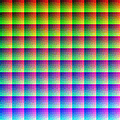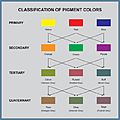Colour facts for kids
Colour (or color) is how we see different types of light. It's a special feature of light that our eyes can detect. The word "color" (without a 'u') is used in the United States and comes from Latin. In traditional English, it's spelled "colour" (with a 'u').
Some of the most common colour names are:
- Red
- Orange
- Yellow
- Green
- Blue
- Purple
- Brown
- Magenta
- Tan
- Cyan
- Olive
- Maroon
- Navy
- Aquamarine
- Turquoise
- Silver
- Lime
- Teal
- Indigo
- Violet
- Pink
- Black
- White
- Gray
Contents
How We See Colors
Our eyes have special cells that react to different wavelengths of light. These cells send signals to our brain, which then interprets them as different colours. Objects don't actually have colour themselves. Instead, they reflect certain colours of light and absorb others. The colour we see is the light that bounces off the object and reaches our eyes.
What Are Primary Colors?
Primary colours are special because you can mix them to create almost any other colour. There are different sets of primary colours depending on what you are mixing.
Mixing Light Colors
For things like television screens, computer monitors, and stage lights, the primary colours are red, green, and blue. When you mix these three colours of light together, you get white light. This is called additive mixing because you are adding light.
Mixing Pigment Colors
When you mix paints, inks, or crayons, you are using pigments. The traditional primary colours for pigments are red, yellow, and blue. However, modern printers use magenta, yellow, and cyan as their primary colours. They also use black ink to make darker shades and sharp text. This is called subtractive mixing because pigments absorb certain colours of light, subtracting them from white light.
Understanding Color Blindness
Some people see colours differently or cannot see certain colours at all. This is called colour blindness. It usually happens when the special cells in their eyes that detect colour don't work correctly. Most people who are colour blind are male.
Colors in Food
Sometimes, colours are added to food to make it look more appealing. Food colouring is used for this purpose. However, many foods have their own natural colours, like the orange colour in carrots, which comes from something called beta carotene.
Transparent and Translucent
When something has no colour and you can see right through it, it is called transparent. A good example is clear air or a clean glass window.
A translucent material is different. You can still see light through it, but you can't see clear shapes or details on the other side. Think of stained glass or frosted glass; they might have a colour, but they are not transparent.
The Science of Color
The study of colour is a fascinating field. It is sometimes called chromatics, colorimetry, or simply color science. Scientists and artists both study how colours work and how they affect us.
Related pages
Images for kids
See also
 In Spanish: Color para niños
In Spanish: Color para niños








